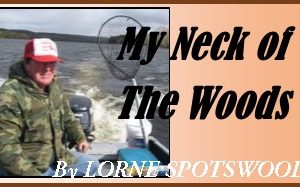When Larry Lafleur arrived at Spotswoods Landing a few years ago, he indicated his fishing partners would be fishing solely for northern pike. I was confident they would catch plenty since they seemed to be knowledgeable anglers. And that is precisely what they found.
“In our two and one-half days of fishing we caught and released over 150 pike,” stated Larry. “And coupled with that, we had that many followers.”
Spring is a great time to catch plenty of pike with critters up to 10 and 20 pounds. Fishing is productive until the water warms, forcing the fish to leave the shallow bays. By then, weed growth is becoming thick and unsuitable for big pike movement.
There are many techniques for pike angling but the method the Lafleur group perfected is simple yet effective on the Ottawa as well as inland lakes. It is not necessary to be equipped with a modern day fishing craft complete with 15 fishing rods, electronics and all the other paraphernalia carried in some boats. The main ingredient to Lafleur’s successful method is to be mobile, persistent and of course to be an angler who likes to catch at least 25 northerns or more in a day.
LOCATIONS: Concentrate on all the bays or back corners of pike lakes. Pike are not found in every bay but they do move from bay to bay as conditions change. The back bays are top locations as well as points that have weed pockets. Work all the bays systematically and sooner or later the bay with the most fish and the biggest will be found. On some days the active bay may be found early in the day while other times the key bay may not be located until afternoon.
“If you find a bay with noticeable green growth, then work it thoroughly,” stated Steve, Larry’s partner. “This is quite often the key location for productivity.” On our trip in May, one afternoon we found such a bay and hauled out 21 northerns as large as 11 pounds,” related Steve’s brother, Dan. Big northerns move to the bays in search of a big meal and baitfish are available in the shallows in the spring. Work all bays in the spring. Don’t omit any bay, every one is a potential hot spot.
LURES: The Lafleur team always studies the stomach contents of the fish they keep. If the stomachs hold a lot of crustaceans, then the fish are feeding on bottom, use lures that work close to bottom. If sunfish are evident in the stomachs, lures that resemble them are the preferred tackle.
“I place more emphasis on placing a lure where the pike is rather than a certain type of lure,” states Lafleur. “It is important to drop a lure in front or near a spring northern. This necessitates using a lure that will reach pike, weedless lures in weedy areas and deep runners in deeper water zones.”
The Lafleur team does have preferences for lures. Their first choice in colour is simple; anything that resembles a silver lure, then switch to other colours. As for size, they don’t use any lure that is overly big. Something in the three to four inch size is adequate ranging in weight from half to three quarter ounces. One trick is to carry an assortment of trailer hooks that can be added to some lures, especially spinner baits. Lafleur’s list of favourite lures includes spinner baits, spoons (William’s wobblers and daredeils), rapalas, rebels etc. and finally, top water baits. Give the Zara Spook a place in your tackle box for top water pike. It is dynamite.
METHOD: “Our sole technique is casting,” states Lotha Blume. “We are able to produce plenty of pike and casting bays allows us a quick, efficient method of location.” For those anglers who don’t have a trolling motor, then drifting the back bays right into the shoreline will put you in touch with the northerns. A trolling motor will certainly allow an angler to work a back bay easier and perhaps even more efficiently, certainly with less involvement of starting up a bigger outboard and spooking the fish. “We never anchor while fishing bays,” indicates Lafleur. “This goes against our system of casting, moving and locating. Casting is by far our most effective method for catching spring northerns.” Lafleur also does some trolling but only when en route from one bay to another.
TIME OF DAY FOR SPRING PIKE: “Rising before dawn is not necessary for springtime angling,” says Lafleur. Here is why! Northerns typically spend the off-hours (early morning) in an inactive state usually in last year’s weed growth in the centre of the bay or cruising the shoreline. The water is cold (low 40’s in Fahrenheit) and the fish remain inactive til the sun beats down enough to get them moving. Then cruising and prowling in the shallows begins. Days of heavy cloud or very windy conditions result in less penetration by the sun therefore keeping the pike inactive and fishing is usually slow. Good sun exposure is a real asset to productive spring angling.
Pike will not be found in the shallows in early morning. This is due to the temperature of the bay dropping overnight, cooling down the activity. On a good sunny day, activity begins about 10 or 10:30 in the morning. As the sun continues to warm the shallows, more fish enter the shallow zones. By noon, the shallows will see a lot of fish, actually a lot of active fish and big fish as well. With the warm water, the active fish begin their search for food.
As good as pike fishing is in the summer and fall, the potential for taking a trophy is never better than in the spring. Is a 15 or 20 pounder on your agenda? Then be on the water in early spring.





![Kenopic/Smith Auction [Paid Ad]](https://whitewaternews.ca/wp-content/uploads/2018/10/advertising-100x75.jpeg)

